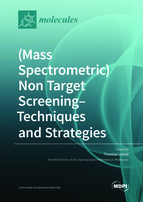(Mass Spectrometric) Non Target Screening–Techniques and Strategies
A special issue of Molecules (ISSN 1420-3049). This special issue belongs to the section "Analytical Chemistry".
Deadline for manuscript submissions: closed (31 December 2022) | Viewed by 51205
Special Issue Editor
Interests: analytical chemistry; environmental analysis; biofunctional analysis; non-target screening workflows; liquid phase separation strategies (RPLC, HILIC, SFC, etc.); mass spectrometry (ionization techniques and analysers)
Special Issues, Collections and Topics in MDPI journals
Special Issue Information
Dear Colleagues,
(mass spectrometric) non-target screening is a preferably comprehensive and untargeted (predominantly organic molecules detecting) approach combining (robust) analytical measurements with adapted data evaluation concepts, systematic compound identification workflows and statistical data interpretation.
It is well suitable for the identification of new, unexpected and/or unknown organic compounds as well as monitoring ‘molecular fingerprints’ and profiling ‘process-relevant’ relevant molecules via statistical methods.
Non-target screening (NTS) provides special benefits for the investigation of complex samples in various disciplines. Even well characterized samples can contain relevant and yet not detected compounds. Depending on the nature of the sample and the aim of the analytics, the presence of such unknown compounds can be of concern and relevance. Non-target screening is a universal technique that can be applied in many areas, such as environmental, forensic, food, metabolomics and other analysis. Since several meetings in 2016 (and later) regarding that topic and many books and publications the NTS topic gains a new level of knowledge and awareness.
Many of them will be presented on the digital workshop ‘Gas Chromatography meets Non-Target Screening’ (see https://afin-ts.de/gc-meets-nts-2022/) to which we want to invite you in November 2022 for an actively participation with a poster and digital discussion groups.
Regarding that conference we ask you to submit also a manuscript for publication in this special issue in the analytical chemistry section. The focus will not be on the applications themselves, but on the techniques, strategies, NTS software and platforms as well as data evaluation workflows and other developments in NTS. Several submissions are asked to present a detailed and transparent quality assurance in both, the analytical and data handling performances.
If you are interested to publish your resent developments open-access do not hesitate to contact me.
Dr. Thomas Letzel
Guest Editor
Manuscript Submission Information
Manuscripts should be submitted online at www.mdpi.com by registering and logging in to this website. Once you are registered, click here to go to the submission form. Manuscripts can be submitted until the deadline. All submissions that pass pre-check are peer-reviewed. Accepted papers will be published continuously in the journal (as soon as accepted) and will be listed together on the special issue website. Research articles, review articles as well as short communications are invited. For planned papers, a title and short abstract (about 100 words) can be sent to the Editorial Office for announcement on this website.
Submitted manuscripts should not have been published previously, nor be under consideration for publication elsewhere (except conference proceedings papers). All manuscripts are thoroughly refereed through a single-blind peer-review process. A guide for authors and other relevant information for submission of manuscripts is available on the Instructions for Authors page. Molecules is an international peer-reviewed open access semimonthly journal published by MDPI.
Please visit the Instructions for Authors page before submitting a manuscript. The Article Processing Charge (APC) for publication in this open access journal is 2700 CHF (Swiss Francs). Submitted papers should be well formatted and use good English. Authors may use MDPI's English editing service prior to publication or during author revisions.
Keywords
- mass spectrometric non-target screening (NTS)
- NTS workflows
- NTS strategies
- NTS techniques (separation, ionization, detection)
- HPLC
- SFC
- GC
- CE
- HRMS
- MS/MS
- NTS software solutions
- NTS open access software
- NTS data evaluation
- NTS and quality management







